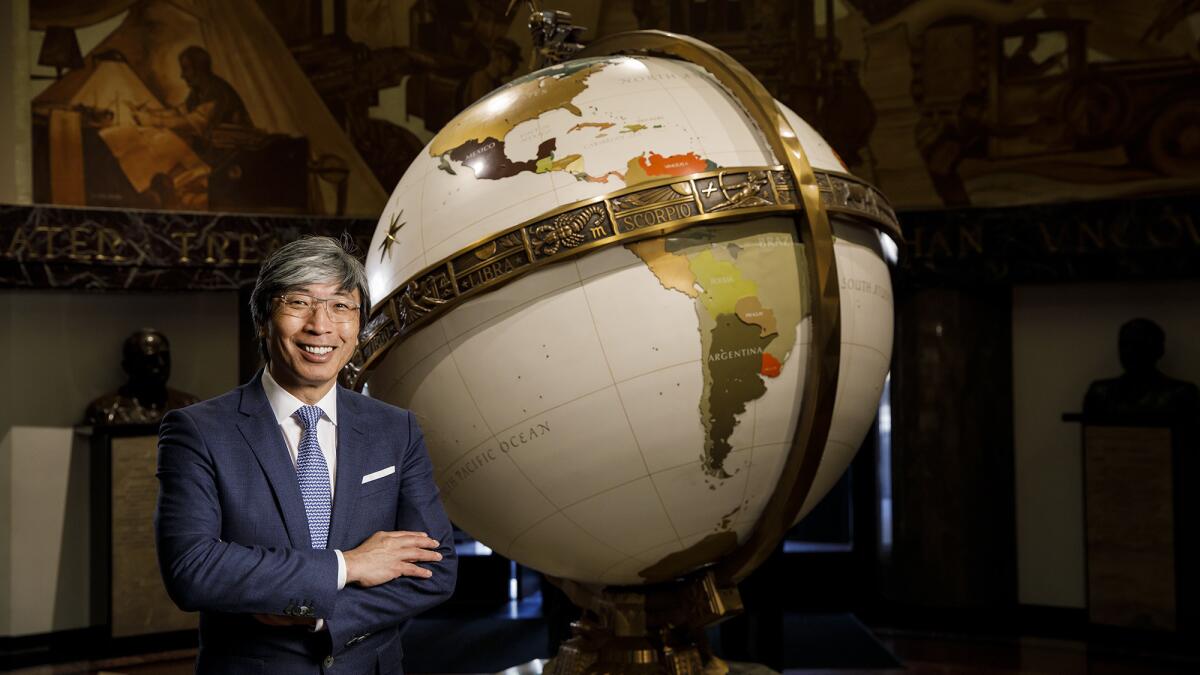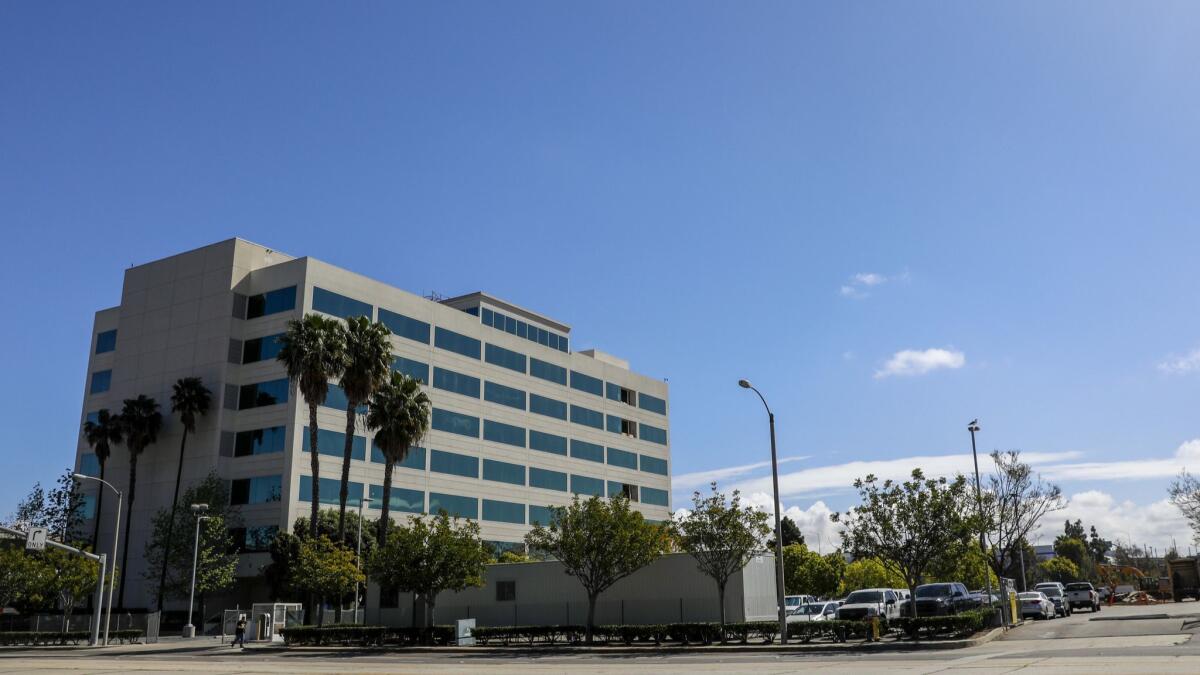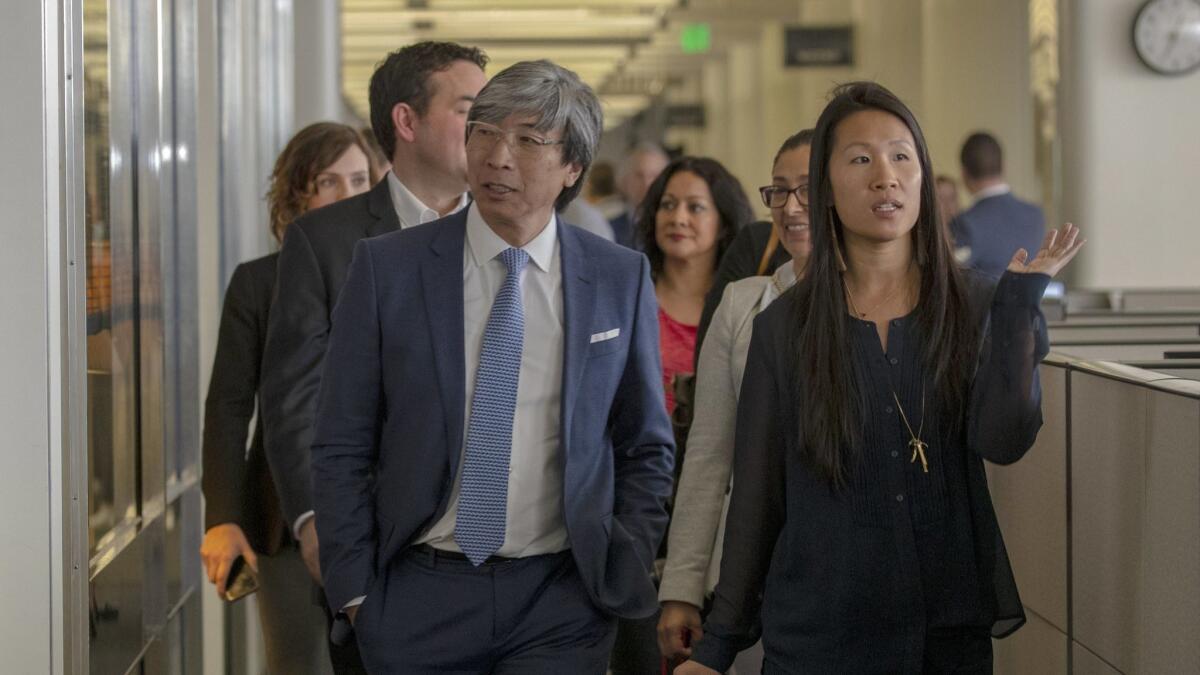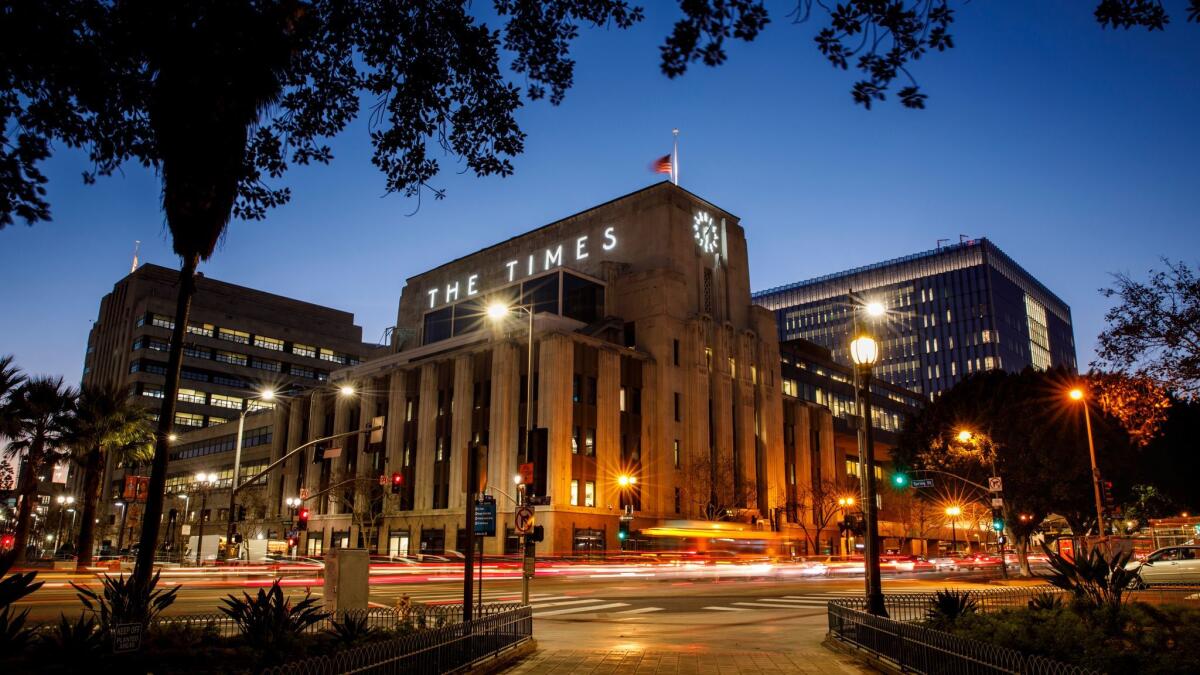Historic sale of the L.A. Times to billionaire Patrick Soon-Shiong to close on Monday

Biotech billionaire Dr. Patrick Soon-Shiong on Monday will take control of the Los Angeles Times and San Diego Union-Tribune, two historic newspapers rooted in Southern California civic life for more than 135 years — that now must adapt for the digital age.
Soon-Shiong is spending $500 million to acquire the news organizations, along with Spanish-language Hoy and a handful of community newspapers, from Chicago-based Tronc. The deal, which was announced Feb. 7, returns The Times to local ownership after 18 turbulent years under Chicago control.
Changes will be felt almost immediately. Soon-Shiong, who will become executive chairman of the California News Group, plans to relocate most of the 800 employees to El Segundo by the end of July, vacating the paper’s iconic Art Deco headquarters in downtown Los Angeles — The Times’ home since 1935.
Previous corporate owners two years ago had sold the building, and the paper’s lease expires June 30. Rather than pay a substantial rent increase, Soon-Shiong opted to shift the operation to a building near Los Angeles International Airport that he bought last year. The building was gutted, and during the last three months, Soon-Shiong and his wife, Michele B. Chan Soon-Shiong, have spent millions of dollars creating a 21st century newsroom that encourages collaboration. (Some local government reporters will remain downtown.)

Soon-Shiong, a 65-year-old South African native and former UCLA surgeon, has amassed a fortune, estimated by Forbes at $7.5 billion, by building, then selling, two biopharmaceutical companies. Since then, he has been on a mission to personalize cancer treatment and develop vaccinations for deadly diseases. He owns a nearly 4.5% stake in the Lakers and last year swooped in to buy six financially strapped California hospitals, including St. Vincent and St. Francis in Los Angeles.
But owning the Los Angeles Times is his highest-profile venture — and his legacy probably will be formed by his efforts to revitalize a weary newspaper group facing an uncertain future as advertisers gravitate to Google and Facebook, where readers are consuming more news.
“This will be his toughest challenge yet,” predicted political consultant and pollster Frank Luntz, who occasionally works with Soon-Shiong. “The printed word is on life support — but the doctor is in.”
The Times once boasted one of the world’s largest newsrooms, with more than 1,200 journalists and more than 25 foreign bureaus in far-flung cities including Vienna, Nairobi, Seoul and Saigon. Now it employs about 400 journalists and maintains bureaus in Sacramento and Washington along with a handful of foreign and national outposts. Dozens of writers and editors in recent years have left for other news outlets.
Soon-Shiong has promised to rebuild The Times and to bring stability to a newsroom that has been led by three editors in 10 months and five publishers in four years. His purchase saved the paper from more steep cuts as Tronc had been making plans to close The Times’ Washington bureau and, according to Soon-Shiong, lay off as much as 20% of the staff.
Since March, he has taken a crash course in newspapering by reaching out to high-profile news veterans, including Norman Pearlstine, a former top editor and business executive at Time Inc., whom Soon-Shiong hired this spring as an advisor to help with the transition. He has also sought input from Dean Baquet, executive editor of the New York Times (and former top editor at the Los Angeles Times); Marty Baron, executive editor of the Washington Post (another Times alum); Donald Graham, former owner of the Post; longtime Washington columnist Al Hunt; former Times publisher Tom Johnson; and Judy Woodruff, anchor of the PBS “NewsHour.”
“The last three months has been an amazing experience for me to really learn — I mean on a steep learning curve — about all the elements that are affecting this industry,” Soon-Shiong said Friday in an interview at the soon-to-be headquarters in El Segundo, just after signing paperwork to finalize the purchase. On Monday, he will wire the money — and then the historic sale will be complete.
A Tronc spokeswoman declined to comment on Saturday.
“I’ve also spent time trying to understand what is the next evolution of our papers in order to survive,” Soon-Shiong said. “But survival is not the motivation that we have…. It’s really to thrive.”
He has talked in arching terms about continuing The Times’ tradition of investigative reporting and elevating its coverage of health, science, the environment, technology and entertainment, including sports, and events in Washington. “This is one of the most important times in our nation in politics,” he said. “So we have to be there.”
He said he would like a vibrant opinion section featuring columnists with different and compelling points of view. He is intrigued by long-form journalism and videos, podcasts and special events. He intends to improve the paper’s technology to help deliver articles seamlessly on different publishing platforms to reach new readers. And he wants to turn The Times into a resource for the community, with public events and educational forums — and a world-class test kitchen that Michele is helping design.

But those big ambitions will require a heavy investment at a troubled time for the industry.
“I don’t think he’s looking to make a lot of money, but he’s certainly going to run it as a business,” said Pearlstine. “He does feel like there is content that people will pay for.”
Ravaged by the flight of advertising dollars to the internet, newspapers across the country have slashed news pages and journalists as department stores, car dealerships and other advertisers trim their ad buys because their customers, too, are flocking to online sites. Classified ads once buoyed the industry but have largely disappeared.
Advertising revenue for newspapers in the U.S. peaked in 2005 at nearly $50 billion but had tumbled to less than $17 billion by last year, according to consulting firm PwC. Recent tariffs imposed by the Trump administration have increased the cost of newsprint produced in Canada.
Self-inflicted wounds by The Times’ then-parent company, which also owns the Chicago Tribune, Baltimore Sun and Orlando Sentinel, were particularly damaging. A doomed 2007 leveraged buyout left Tribune Co. drowning in $13 billion in debt and led to a four-year slog through Bankruptcy Court.
Private equity firms that brought the papers out of bankruptcy — Oaktree Capital Management and Angelo, Gordon & Co., along with bank JPMorgan Chase — in 2014 exacerbated the problems by separating the newspapers from the more profitable TV stations, internet sites and real estate holdings. The newspaper company also was forced to pay $275 million to the TV side, which left the newspapers deep in debt.
The corporate breakup led to the sale in 2016 of The Times’ downtown L.A. headquarters for about $100 million; the historic Tribune Tower in downtown Chicago for $240 million; and The Times’ Olympic Boulevard printing plant complex, on nearly 25 acres off the 10 Freeway, for $120 million. The newspapers did not receive those proceeds. (The Times still owns its printing presses.)

Jeffrey Cole, director of the Center for the Digital Future at the USC Annenberg School for Communication and Journalism, predicted that print newspapers would eventually die.
“Today, teenagers don’t read newspapers — and they never will,” Cole said. “But that does not mean there is a lack of interest in news.”
Readership has migrated to computers — and, increasingly, to mobile phones and tablets. About 45% of U.S. adults learn about news through a smartphone or tablet, compared with 21% in 2013, according to a 2017 Pew Research Center survey.
To capitalize on the trend, well-resourced East Coast papers have thrust themselves into the vanguard of digital media by investing in staff and technology. The New York Times now boasts nearly 2.8 million digital-only subscribers while the Washington Post and Wall Street Journal each have more than 1 million.
The Los Angeles Times, in contrast, has about 138,000 digital-only subscriptions. Soon-Shiong said that base must grow.
“He has got to invest in the newsroom,” said Douglas Arthur, an analyst with Huber Research Partners in Greenwich, Conn. “The future of a once-great and a potentially great newspaper is to have great journalism. You have to give readers a reason to buy a digital subscription.”
The Times, despite its trials, remains profitable, though Tronc doesn’t release financials for individual properties. Its digital edition generates about 33 million unique visitors a month, according to measurement firm ComScore. About 690,000 subscribers receive the Sunday paper, while weekday circulation is about 440,000, according to figures from the Alliance for Audited Media.
“The hunger for news is greater than it has ever been,” Cole said. “And one healthy development … was billionaires stepping in to save newspapers.”
In 2013, Amazon founder Jeff Bezos bought the Washington Post and Boston Red Sox co-owner John Henry bought the Boston Globe. Minnesota Timberwolves owner Glen Taylor took over the Minneapolis Star Tribune in 2014.
“These guys are stepping in to save these institutions for the greater good,” said Needham & Co. media analyst Laura Martin. “They are rescuing the Fourth Estate.”
Media baron Rupert Murdoch refused to sell his portfolio that includes the Wall Street Journal, the money-losing New York Post, the Times of London and papers in Australia, even when prospects for papers were particularly bleak. The Journal, in recent years, also has grappled with print revenue declines by cutting staff and combining sections.
Like the dynasty that spanned nearly 120 years — beginning in the 1880s with the iron-willed Gen. Harrison Gray Otis (a Civil War and Spanish American War veteran) and passed on to his Chandler family descendants through the 1990s — Soon-Shiong wants his family to control The Times for the next century. The doctor, who first invested in Tronc two years ago, paid a premium for what’s known as the California News Group, which also includes the Glendale News-Press and the Daily Pilot in Costa Mesa. In addition, he assumed $90 million in unfunded pension liabilities, stemming from the San Diego Union-Tribune.
Although Soon-Shiong said The Times must grow digitally, he said he has no plans to step away from print.
“We will be the last man standing if that’s what it takes,” he told employees during an April town hall meeting.
Soon-Shiong’s mission to heal The Times after years of corporate upheaval and cost-cutting won’t be easy.
The last two years have been particularly tumultuous. Chicago entrepreneur Michael Ferro in 2016 became the largest shareholder in Tribune Publishing and renamed the company Tronc (Tribune Online Content) — a moniker that was widely ridiculed. Ferro’s regime crafted slogans about how it planned to train writers to “turn pixels into Pulitzers” and “feed [journalism] into a funnel and optimize it” to reach global audiences.
Staff reductions, clunky technology and disruptive online ads have hampered the paper’s digital progress. In a sweeping shakeup that ousted several top editors last August, former Fox executive Ross Levinsohn was installed as publisher. His tenure lasted five months. His handpicked editor in chief, Lewis D’Vorkin, was bounced after three months amid contentious interactions with staff.
In late January, The Times’ newsroom voted overwhelmingly to join a union. Leaders of that drive are now focusing on correcting what they describe as years of pay inequities for younger journalists, minorities and women. Soon-Shiong said his team will begin work with the union almost immediately.
The Los Angeles Times Guild, in a statement, said it also was looking forward to working with Soon-Shiong and that it was time for the organization “to think big again.”
“You can bring back hope by investing in the newsroom,” the Guild said. “Give journalists better security, give them a strategy they can believe in, give them independence.”
Soon-Shiong acknowledged that the last few years have “been very rough in the newsroom and rough for the paper.” He said his first mission will be to build the newsroom into a vigorous operation known for its “honest and fair” news. A robust opinion section will come next.
He also has big plans for the Los Angeles Times Studio, which he wants to help push the paper more aggressively into new areas of business, including podcasts and documentaries.
Although the deal was announced in February, negotiations to close the deal were protracted and tense — centering largely on terms for agreements on services, including website operations, which will be shared with Tronc for the next year.
Then in early June, Ferro’s plan to sell his nearly 26% stake in Tronc collapsed. That motivated Soon-Shiong — who has feuded publicly with Ferro — to stitch up the deal.
“I worried that if we didn’t close that would be the end of the L.A. Times,” he said.
Soon-Shiong, through his investment firm Nant Capital, remains Tronc’s second-largest shareholder with a nearly 25% stake. He has said he has no plans to sell.
“I hope that I can convince the board to drop the name Tronc,” he said. “I think we need to go back to Tribune…. The legacy of this [company] needs to be respected and I always thought Tronc was a silly name.”
It is not clear how involved Soon-Shiong will be in The Times’ day-to-day decisions — or whether he plans to reshape the liberal viewpoint of the newspaper’s editorials. Soon-Shiong says he is an independent.
USC’s Cole said Soon-Shiong’s true test may be involving himself in the newspaper — without getting too involved.
“Whether he purchased the paper for pride or personal ego, he needs to keep his thoughts and opinions to the editorial pages,” Cole said. “Then he can get immense credit for saving the newspaper and making it a paper that L.A. deserves.”

Times staff writer Andrea Chang contributed to this report.
[email protected] | Twitter: @MegJamesLAT
UPDATES:
12:50 p.m.: This article was updated to include a comment from the Los Angeles Times Guild.
This article was originally published at 11:25 a.m.
More to Read
Inside the business of entertainment
The Wide Shot brings you news, analysis and insights on everything from streaming wars to production — and what it all means for the future.
You may occasionally receive promotional content from the Los Angeles Times.











